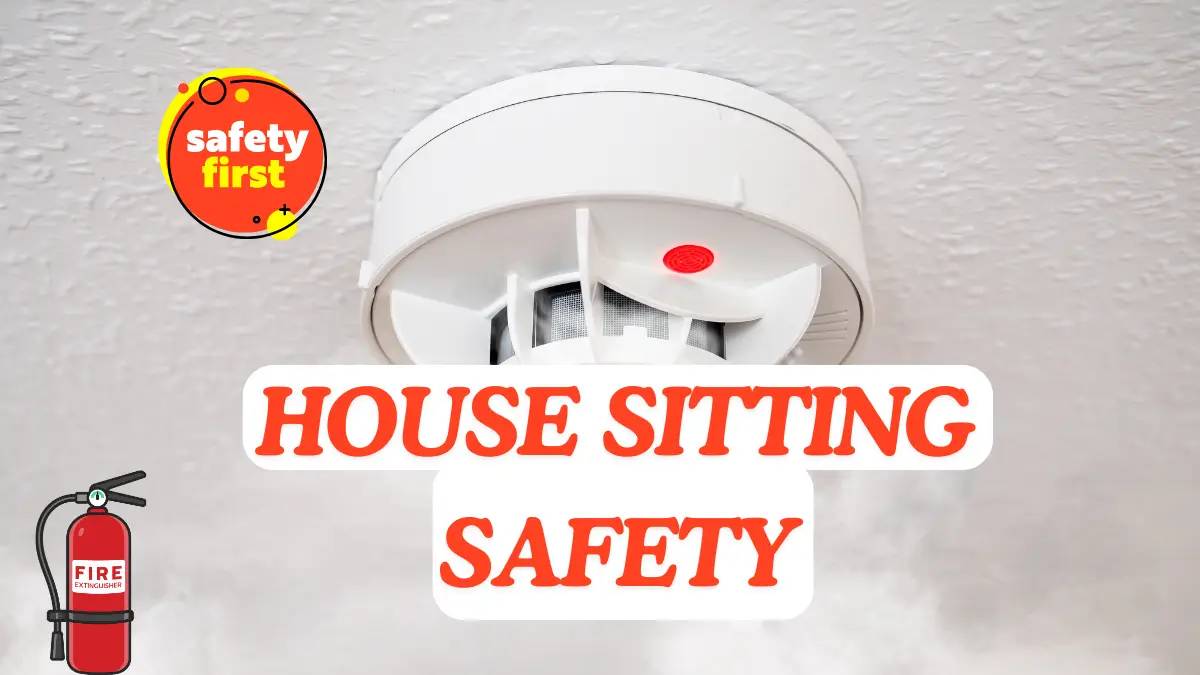7 Essential Steps to Handle a Fire Alarm While House Sitting with Pets
7 Essential Steps to Handle a Fire Alarm While House Sitting with Pets Facebook Youtube Tiktok Instagram As a traveling pet sitter, you can never be prepared enough for the unexpected. Being prepared for events, is part of being a pet and/or house sitter. This situation presented itself to…
7 Essential Steps to Handle a Fire Alarm While House Sitting with Pets
As a traveling pet sitter, you can never be prepared enough for the unexpected. Being prepared for events, is part of being a pet and/or house sitter. This situation presented itself to me just recently, so I wanted to share safety tips as a reminder for all of us.
Table of Contents
Fire Alarm Safety
House sitting with pets is a wonderful opportunity to experience new environments, meet delightful animals, and enjoy a sense of responsibility. However, unexpected situations like a fire alarm can be daunting. When the alarm goes off, it’s crucial to stay calm and follow a clear plan to ensure the safety of both yourself and the pets in your care. This article provides a detailed guide on how to handle a fire alarm while house sitting, ensuring everyone remains safe.
1. Stay Calm and Assess the Situation
The first step when a fire alarm goes off is to remain calm. Panic can lead to poor decision-making and increased risk. Take a deep breath and quickly assess the situation:
- Look for signs of fire or smoke: Check if there are any visible signs of a fire, such as smoke or flames. Use your senses—listen for crackling sounds and sniff for burning odors.
- Determine the source of the alarm: Sometimes, a fire alarm can be triggered by non-emergency situations like cooking smoke or steam from a shower. If you can quickly identify a harmless cause, you may be able to reset the alarm.
If you confirm there is no immediate danger, you can turn off the alarm and ventilate the area. However, if you suspect a fire, proceed with caution and assume the worst-case scenario.
Related: Dog Grooming Tips for New Pet Owners
2. Gather Essential Items
If you determine that evacuation is necessary, gather essential items as quickly as possible. Prioritize items that are crucial for safety and identification:
- Leashes and carriers: For pets, having leashes, carriers, or cages ready will make evacuation smoother. Make sure pets are secured before you leave the house.
- Emergency kit: If the homeowner has an emergency kit, locate it quickly. This kit should include items like a flashlight, a first aid kit, water, and pet supplies.
- Personal belongings: Grab your phone, keys, and any important documents or identification that you can easily access. Do not waste time collecting valuables if it puts you at risk.
3. Evacuate the House Safely
Once you have gathered the necessary items, it’s time to evacuate. Follow these steps to ensure a safe exit:
- Plan your route: Use the safest and most direct route to exit the house. Avoid using elevators and stick to the stairs.
- Keep low if there’s smoke: If you encounter smoke, stay low to the ground where the air is clearer. Crawling on your hands and knees can reduce the risk of inhaling smoke.
- Close doors behind you: As you exit each room, close the door behind you. This can help contain the fire and slow its spread.
If the house has a pre-established fire evacuation plan, follow it closely. Make sure all pets are secured and proceed to the designated meeting spot outside.
4. Call Emergency Services
Once you and the pets are safely outside, immediately call emergency services. Provide them with the following information:
- Address of the house: Clearly state the address and any nearby landmarks to help responders locate the property quickly.
- Description of the situation: Briefly explain what you observed inside the house, such as smoke or visible flames.
- Information about the pets: Mention the presence of pets and any relevant details that could assist firefighters in their response.
Stay on the line with the emergency dispatcher until you are told to hang up. Follow any instructions they provide and stay at a safe distance from the house.
5. Ensure Pets Are Safe and Comfortable
After evacuation, it’s essential to ensure the pets in your care are safe and comfortable. Here are some steps to take:
- Keep pets secure: If you evacuated with pets in carriers or on leashes, keep them secure. They may be frightened by the noise and chaos, so maintaining control is important.
- Check for injuries: Look for any signs of distress or injury in the pets. If a pet is injured, provide basic first aid if possible and seek veterinary care once it’s safe.
- Offer reassurance: Speak calmly to the pets to reassure them. Your calm demeanor can help soothe their anxiety in the chaotic situation.
If you have access to a safe area, like a neighbor’s home or vehicle, consider moving the pets there temporarily while you wait for emergency services.
Would you like to be a pet sitter in your local area? Sign up with our link today. Get Started!
6. Communicate with Homeowners
Once the immediate danger is under control, it’s important to communicate with the homeowners. Here’s how to approach the situation:
- Contact them as soon as possible: Call the homeowners to inform them of the situation. Be honest and clear about what happened and the current status of their home and pets.
- Provide updates: Keep them updated with any new information you receive from emergency responders or neighbors.
- Offer assistance: Ask if there is anything specific they need you to do, such as contacting insurance or making arrangements for temporary accommodation.
Homeowners will appreciate being kept in the loop and knowing that you are managing the situation responsibly.
7. Learn from the Experience
After the incident, take some time to reflect on the experience. Consider what went well and what could have been improved. Use this opportunity to prepare for future emergencies by:
- Reviewing safety plans: If the house had a fire safety plan, review it and suggest any improvements to the homeowners if necessary.
- Updating emergency contacts: Ensure you have current emergency contact information for the homeowners and their preferred vet in case of pet-related emergencies.
- Educating yourself: Research fire safety tips and best practices for pet sitters to be even more prepared in the future.
Handling a fire alarm while house sitting with pets can be a stressful experience, but by following these steps, you can ensure the safety and well-being of everyone involved. Being prepared and knowing how to respond in an emergency is a vital part of responsible house and pet sitting.
By taking the time to learn and prepare for emergencies, you can continue to offer top-notch care and peace of mind to homeowners and their beloved pets.

What About the Carbon Monoxide Detector?
Many modern home fire alarms are also equipped with carbon monoxide (CO) detectors. Carbon monoxide is a colorless, odorless gas that can be deadly if inhaled in large amounts.
Having a dual-function alarm ensures that you are alerted not only to the presence of smoke and fire but also to potentially dangerous levels of CO in the home. This is particularly important when house sitting, as it adds an extra layer of safety for both you and the pets.
If the alarm goes off and it’s a CO alert, evacuate immediately, as CO poisoning can occur quickly and without warning. Ensure you know where the CO detector is located in the home and how to respond appropriately if it is triggered.
Steps to Take if a CO Detector Goes Off
Step 1: Stay Calm
Remain calm and ensure everyone stays focused. Do not ignore the alarm, even if you suspect it might be a false alarm.
Step 2: Ventilate the Area
Open windows and doors to allow fresh air to circulate and dilute the concentration of carbon monoxide.
Step 3: Evacuate Immediately
Get everyone, including pets, out of the house immediately. Do not stop to gather belongings.
Step 4: Call Emergency Services
Once you are at a safe distance, call 911 or your local emergency number to report the alarm and any symptoms you may have noticed.
Step 5: Seek Medical Attention
If anyone exhibits symptoms of CO poisoning, such as headaches, dizziness, or nausea, seek medical attention immediately.
Step 6: Do Not Re-enter Until Safe
Do not return to the house until emergency services confirm it is safe to do so and the CO source has been identified and resolved.
Recommended Products
You may wish to add the following items to your vehicle to ensure you have the item on hand while traveling.
It is always a good idea to check the batteries in the fire alarm once a month or as often as you feel necessary to be sure they are in working order.
Has the fire alarm gone off while you were house or pet sitting a home? What steps did you take? Were you prepared? Were there things you wished you had done differently? Drop a comment and share your experience!
This page contains products we recommend on Amazon. We are an affiliate member of the Amazon Associates Program. If you make a purchase using one of our links, you are helping to support our endeavors. We may receive a commission. Thank you for your support.
fire alarm fire alarm fire alarm fire alarm fire alarm fire alarm fire alarm fire alarm fire alarm








